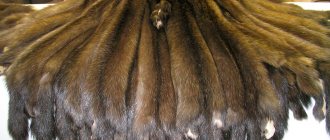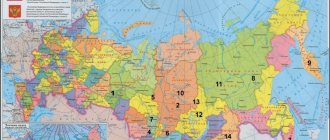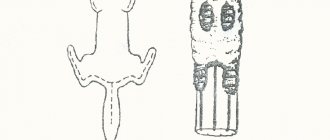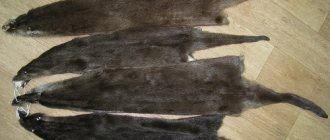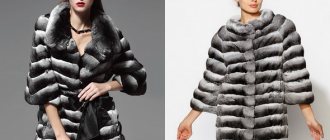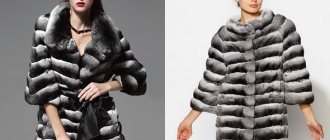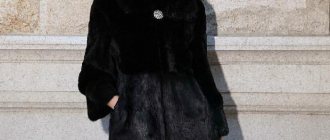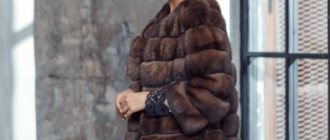Not every owner of a natural fur coat thinks about how many animal skins are used to sew it. It is worth noting that the amount of raw materials is closely related to the size of the product, its length, style and other nuances. For sewing fur coats, mink, rabbit, nutria, chinchilla, marten and other animals with valuable fur are used.
Photo source: pexels.com Of course, a fur coat is a good thing... if not for the fact that it is made from killed animals. Many people think that caring for animals is nonsense and are more inclined to take care of their own warmth. Others are haunted by the fact that innocent animals are being killed for the sake of fashion and beauty, and call for abandoning natural fur. Of course, the issue is debatable.
However, for a better understanding of the problem, we suggest that you familiarize yourself with interesting facts - find out how many skins you need to sew one fur coat.
Finding out how many skins are needed for fur coats of different styles
Fur coats made from natural sable fur have always been popular among the fairer sex. Moreover, both young girls and older women showed love for such products equally. But none of the fashionistas ever thought about the number of natural skins that are required to sew one luxurious fur coat. But it’s interesting to know how craftsmen calculate the required amount of fluffy material for sewing a product of medium length.
How many fox skins do you need for a short fur coat?
To create a short fox fur coat in the style of a medium-sized car lady (42-46 rubles), you need from 15 to 25 skins with a length of about 85 cm (calculated from the tips of the ears to the base of the tail). Before buying the material yourself, you need to contact a specialist who will take measurements and calculate the exact number of skins. To do this, the designer needs information regarding the breeds of the selected skins (red fox, arctic, vole, white, black-brown), because animal fur differs not only in the thickness and length of the pile.
Moreover, when sewing a short fur coat, you can effectively combine types of skins, the required quantity of which will be advised by a specialist.
Facts about natural fur coats
Mink or sable skin has always been valued among fashionistas. At all times, natural products were sold for a high price, which was justified by their impeccable quality. Outerwear made of natural fur retains heat perfectly and retains its attractive appearance for a long time. Fashionistas are also attracted by the beautiful color scheme, which cannot be reproduced artificially. Natural fur shimmers in beautiful shades in the sun.
Arctic fox fur coat
If we talk about sable fur, it is naturally black, grayish and white. The rarest and most expensive is white fur. Barguzin sable fur is also expensive. Mink dressing is no less popular. Often used for sewing fur coats of different lengths and styles.
ALL ABOUT CHINCHILLA FUR
From season to season, the popularity of clothing made from natural fur is growing. Luxurious mink is not inferior to the leading position. However, designers are not limited in the choice of material. The new brand collections have a huge selection of models made from a variety of fur raw materials.
Lovers of exclusive elegant products were not left without attention. For them, couturiers offer luxurious items made from the exotic animal chinchilla. The elastic soft skins of this small animal are transformed into exquisite fur coats in the skillful hands of fashion designers.
Counting the quantity
To accurately calculate how many mink skins you need for a fur coat, you first need to decide on the following data:
- style,
- size,
- the length of the future finished product.
In addition to the parameters of the fur coat, remember that the final number of skins will depend on their size. The smaller the animals, the more mending will be required to sew the product. Craftsmen know another trick that affects the number of skins required for a fur coat. It turns out that female sable and mink are smaller than males. This means that more fur preparations for females will be required than for males.
When calculating how many mink skins are needed for a fur coat, the customer should know that the collar, pockets and other decorative additions increase the number of stitches. Accordingly, the price of the finished product increases.
Statistical data
Humanity has long been engaged in sewing various products from natural fur. The craftsmen even came up with some kind of statistics that show how many skins are needed for a short, knee-length, floor-length fur coat. According to the data, at least 8 skins will be required for a fox outerwear.
- From chinchilla fur, you need about 160-170 skins for a knee-length fur coat.
- A similar product made of sable will require 60 repairs.
- From beaver - 20 skins.
- Of otters - 25.
- For a beautiful knee-length mink fur coat, you need to use the fur of 55 animals.
- To sew a product from squirrel fur, you need to use the skins of 200 individuals.
- A knee-length fur coat of marten fur is created from the skins of 55-60 animals.
Lamb fur coat
To sew a beautiful fur coat from lamb fur, you will need to trim 20-30 animals, depending on their size. To sew a product slightly below the hip length - 16-18 skins. A short sheepskin coat will be made from 8-10 skins of young lambs. What does a young lamb fur coat look like? This is the well-known astrakhan fur, which stands out from other furs with its original curls of curls located throughout the trim. To produce products, craftsmen use the fur of three-day lambs. It is at this age that the stuffing is distinguished by its softness.
What is the advantage of an astrakhan fur coat made from whole pieces of fur? This product is warm, wearable and durable. In the color range, astrakhan fur is presented in black, white, gray and brown. Craftsmen recommend using the dressing of Afghan lambs for sewing fur coats. This material is the warmest and most durable. With average financial capabilities, you can give preference to Uzbek karakul. It costs less than the Afghan one, but is not inferior to the first in terms of durability and strength.
We will learn from the video how to correctly calculate the required number of skins for sewing a medium-length fur coat.
Descriptions of chinchilla fur
The natural habitat of small, attractive chinchilla rodents is the regions of South America. These are mainly mountain ranges:
The beautiful animal was brought to Europe by the Spaniards. Chinchilla products are rapidly gaining popularity. To meet the growing demand for exotic animals, French breeders developed a technology for breeding them in captivity.
Currently, furry rodent skins are supplied to the market by fur farms in many countries around the world. Raising these animals has certain difficulties. Therefore, supplies of this raw material are scarce.
This is one of the most expensive materials.
Prices at fur auctions for small pelts start at $100. It depends on the quality and shade of the chinchilla fur.
Miniature fluffy rodent, has dimensions:
• body length 22-38 cm;
• tail length 10-17 cm.
Animal skins have the following properties:
• elastic, delicate pile;
• original three-color color.
Airy soft chinchilla fur has a high heat capacity.
Unique warm chinchilla fur coats belong to the luxury class.
Reasons for the high cost of such clothing:
• complexity of cutting and sewing.
The dimensions of the skins are 13x23 cm or 16x30 cm. Their dressing and modeling is complex, labor-intensive and refined. To make one fur coat, depending on the sewing technology and style, you will need from 100 to 300 pieces. Such expensive items that require careful and delicate care are not suitable for everyday wear.
For going to work, you can buy any model made from Rex, which is many times cheaper. The specially bred breed is called the chinchilla rabbit due to the external similarity of the fur.
These photos show Rex fur coats that look very impressive.
Fashionistas of the city of Nizhny Novgorod are invited to the online store from “Roxan” to get acquainted with the luxurious collection of royal rabbit coats, which are not inferior to chinchilla fur coats.
Number of mink skins per coat
Our beloved mink fur is endowed with the natural qualities of silkiness and shine. In order to sew a mink coat, animals are not caught in wild forests, as some people think. To sew fur coats, animals are used that were raised specifically for this purpose on a specialized farm. Minks are bred en masse in North America, Russia, and Scandinavian countries. The most valuable fur is considered to be that of a female mink, which is why fur coats made from females are more expensive than those made from males. The price of a fur coat, that is, its value, depends on several factors: size, color, and quality of the skin. Thanks to various methods and methods of breeding, raising animals, and subsequent processing of skins, the range of quantities of mink skins per fur coat becomes very impressive. Most often, mink coats are brown. This is the standard. The fur itself has the property of plasticity, and as everyone knows, it is very resistant to wear. It is thanks to all these properties that manufacturers are happy to sew fur coats of various models for you. If the treatment of a fur coat is raised to the ideal, then it can become a faithful friend for you for a good thirty years. Mink coats themselves are popular not only in our cool country, but throughout the world. After all, this is not just a means of keeping warm, but an indicator of status. It is important that in addition to good heat retention, mink fur is not lost when wet. For people who are lucky enough to live in a harsh climate, a mink coat is an ideal option, and the longer it is, the better. As usual, the fur of males is used to sew hats and collars. It is thicker and denser to the touch. If you sew a fur coat from this fur, it will be quite heavy and not very comfortable. Jackets are often made from the skins of males. The skin is very thick and dense, so it will protect from any frost. It is logical that the price of the skin directly depends on the size of the animal. It is clear that the larger the skin, the more profitable it is to sew from it. Many people are interested in the number of mink skins per fur coat that should be used. We give you the long-awaited answer to this question: in order to sew a mink coat of a classic model, as expected, with a collar approximately knee-length, you will need forty-two female mink skins, or twenty-two male skins.
Chinchilla skins
Chinchilla is an animal that came to us from South America. In a short time, it gained popularity due to its thick and soft fur. Products made from chinchilla fur are highly valued for their consumer qualities, and therefore are in high demand. If you are interested in breeding chinchillas, if you want to buy chinchilla skins , this site is for you! Here you can purchase both chinchillas and chinchilla skins . and also obtain the necessary information on the issue of interest by contacting us.
What do we offer?
- We offer chinchillas raised in Ukraine. Animals are kept in accordance with all necessary requirements, including balanced nutrition and climatic conditions. As a result, the animal fur is of the highest quality.
- The skins are cured using American technology using the drug Lowenstin, the manufacturer of which is the only one who produces specialized products for this area.
- At the final stage of processing, the fur is treated with an antistatic agent and polished, after which it is completely ready for sewing.
- The skins undergo periodic testing for mechanical strength and chemical resistance, showing excellent results.
By purchasing chinchillas and chinchilla skins from us, you can be sure of an excellent result.
We will buy chinchilla skins wholesale
Foreign investors make wholesale purchases of chinchilla skins without dressing
. Regarding the purchase, sale, improvement of quality and storage of raw skins, please contact us for advice..
Alfalfa for rabbits
When deciding to use alfalfa in the diet of rabbits, it is important to know that feeding freshly cut, young or steamed alfalfa can most likely lead to bloat
How to feed giant rabbits
Giant rabbits are a wonderful option for those who want to start their own small business, and for those who are interested in having a good decorative animal. Giant rabbits, due to their fluffiness
Male minks and female minks
The fur of male mink and female mink is very different. Males have a thicker and denser pile, which is well suited for sewing hats and collars. But female minks have softer and sparse fur - it is used for sewing fur coats, coats, fur coats, etc. Approximately how many mink skins do you need for a fur coat? For a classic-cut knee-length fur coat with a collar, you will need at least 40-42 female mink skins or 20-22 male mink skins.
Naturally, the fur of male minks is much more expensive than the fur of female minks, because their skins have very strong and thick skin, the wear of which is higher than the skin of female minks. These skins are used for those areas in the fur product that bear the maximum load. But it is not recommended to sew a long fur coat from the skins of male minks, since the fur product becomes simply heavy and uncomfortable to wear (although wear-resistant and warm).
But mink jackets or short mink coats made from male mink skins show remarkable results. Fluffy, very warm, they will warm you in the bitter cold and save you from the piercing wind. Of course, not every male mink is of great value. For example, the skin of a female North American mink is much more expensive than a male one. Males of European mink, on the contrary, are valued more expensive than females, because the larger the skin, the cheaper the fur product becomes.
The fur of females is more valuable, so expensive fur coats are made from them. The price of a fur coat is influenced by the quality of the skin, color and size. Modern methods of breeding minks and processing their skins lead to a diverse range of products.
Most often the product is made of brown mink. The fur is very plastic and wear-resistant. These qualities enable manufacturers to sew fur coats of various models.
With proper handling and storage, a mink fur coat can last up to 30 years.
Mink coats are popular all over the world. A mink product retains heat well and does not spoil its appearance in wet weather. It is perfect for residents of countries with harsh climates.
Male fur is most often used for sewing collars and hats. It feels denser and thicker to the touch. A fur coat made from such fur will be extremely uncomfortable and heavy. Jackets are often made from the skins of males. Their thick and durable skin will protect its owner in any frost and wind.
The cost of mink skins is also affected by the size of the animal. After all, the larger the skin, the more profitable it becomes to produce products from it.
Many people wonder how many skins are needed for one mink coat. So, for example, for a classic model fur coat with a knee-length collar, you need 42 skins from females, or 22 skins from males.
LiveInternetLiveInternet
1. Sable is an expensive fur. Therefore, often in it, like in no other, an illusion arises according to the well-known wisdom “the more expensive the fur, the better it is.” Since even the cheapest sable is much more expensive than mink, it is assumed that inexpensive sable is better than expensive mink. And this is a big misconception.
In any type of fur, a product of a simpler level, but of higher quality, is always preferable. Then, low-grade products (any type of fur) have one despicable quality - they are a clear indicator of well-being. An original, expensive rabbit may be the whim of a millionaire, and a shabby, shaggy sable, as if in spirit, will tell you about the swan song of the family budget.
Therefore, the principle is simple - determine the budget and see how it compares with a price not lower than the market average. Not enough - reduce the volume of the product: coat - jacket-vest-scarf or trim.
You can take a tricky route - reducing fur consumption by increasing the stitching, since the most expensive snake is cheaper than sable, and the overall picture can be represented as the designer’s creativity.
The most unreasonable thing is to save at the expense of the grade of sable and the quality of tailoring; here everything will be in plain sight and without options.
2. Sable and sable are different. Therefore, it is very advisable to buy it, if not with a specialist, then at least with a practitioner, or from professionals who can show and compare the characteristics with definitions other than “look at how the fur plays in the sun.”
At a minimum, be sure to go to a salon that deals with expensive varieties of sable and see what is valued, feel the high-grade fur, feel its silkiness and thickness.
There are a lot of products on the market made from cheap varieties of sable and painted marten, which are sold as “Barguzina”. If you see a real Barguzin sable once, it will be very difficult to mislead you, especially with low grades.
3. Raw materials
In sable, as in any other commercial fur, it is impossible to ensure unconditional compliance with the standards for the procurement of raw materials. The most problematic skins can be defective at the raw material level and during the dressing process (they fall apart). But, all the same, the skins in the product always initially have different physical and chemical properties, even within a batch from one auction and one dressing. Naturally, the spread of characteristics increases if the skins are supplied in separate small batches, when the skins in the product have different ages and different dressings.
4. The most dangerous drawback of cheap sable is improper dressing.
The most primitive dressing, artisanal, is usually carried out in places close to the extraction of skins. In the overwhelming majority, such skins have a strong “animal” smell and poorly polished flesh. Due to the large amount of residual fat (as evidenced by the smell), the aging process and loss of strength of the inner skin of such skins proceeds much faster.
Industrial dressing of sable takes place under more complex conditions than standard mink, so sable, which is bought on the border with China directly from hunters and sewn by the Chinese, is produced “without any fuss” using standard technology and has reduced strength. When dressing sable, it is advisable to tint the fur; this ensures a better fit into the product and gives the opportunity to transform the color into more valuable dark tones. Only high-tech dressings can produce light, noble tinting of sable. Taking into account the fact that such color alignment has a very beneficial effect on the appearance of the product, we can say that this is one of the clearly visible signs of a product of at least average level.
It happens that with expensive workmanship, tinting is not deliberately done, but in most cases it is present to one degree or another. Chemically perfect (Italian and French) tanning has the ability to strongly tint the sable into a very dark color while maintaining the silky structure of the pile and half-tones of color. Examples of such products can be found in the collections of leading Italian brands. Gray hair is preserved when tinted. It is not possible to get gray hair artificially.
5. Brand level. In most cases, the grade of sable in a product and, accordingly, its total cost, very much depends on the level of the brand. With a high level of raw materials, the cost increases greatly; only firms of a certain level, with a deliberately high price bar and a clientele of a high price category, can afford this. It is practically impossible to find high grade sable in a collection of a small or unknown brand. If you want to purchase an elite-level sable - dark with a lot of gray hair, be prepared for the fact that this is not a momentary process - a product of this class will need to be “caught”: order, negotiate so that you are informed about new arrivals, promptly arrive and make a decision, and “bargaining is appropriate here” will not happen.
6. Tailoring level.
Sable is very different: it is almost impossible to find two completely identical skins. In addition to color and shade, the color/tone of the underfur, the height and density of the pile are also important. The furrier’s task is to place the skins so that nothing is noticeable from the outside; this is a very high class of work; such specialists are the elite of the fur industry.
Or, an initially large volume of skins of the same type is required (which sets a certain status for the company), which makes it possible to improve the quality of the selection, according to the laws of the “quantity to quality” dialectic.
From the point of view of typesetting, the most difficult to manufacture are classic row products, in which the skins must form a single canvas in color and height. If the product shows “chattering” of the skins in color, density or height, this is a low class of furrier’s work and/or a poor selection of fur. The now popular transverse arrangement (especially half-skin) does not have such high requirements for the quality of the selection.
7. Consumption
The sable skin has a very pronounced topography: a low neck with a spot on the throat, turning into a pronounced cross (the area of the shoulder blades), a luxurious fluffy back with a slight dip in the dark ridge, delicate sparse high pile on the belly and flanks, short fur on the paws.
If the product shows strong differences in the height of the fur, there is no noble evenness, there is a feeling of piebaldity and shaggyness, most likely, the entire area of the skin has been used, along with low-value areas of different hairs. In high-end products, only the backrest is used, no further than the crosspiece.
In order to achieve savings in consumption and originality in design (it’s always nice when these two prerequisites coincide in technology tactics), the sable skins in the product are embroidered with different materials.
When positioned vertically, the skins are separated from each other by strips of 5-10 mm thin suede in the color of the underfur, which visually highlights each skin and correctly orients the coattails (in this case, the jointing is purely technological and practically invisible).
When the skins are arranged transversely, wide stripes (up to 70 mm) of the jointing have a great decorative function. In such cases, expensive original materials are used - braid, lace, exotic snake skin, etc.
8. Dry cleaning of sable is a delicate matter both in terms of the chemical process, and in terms of the human factor, and in terms of frequency. Sable will tolerate even proper dry cleaning two or three times, so it should not be done unless absolutely necessary. Therefore, the issue of dry cleaning should be discussed even when purchasing, and the product must be worn carefully (if you are interested in long-term use).
9. The wear resistance of sable is quite high, but in most cases (if you comply with the minimum requirements of the operating rules) this parameter is practically unimportant. The first priority is the strength of the flesh, which decreases quite quickly with age. Therefore, savings by purchasing a used product seem rather doubtful.
Good to know:
- The cost of sable skin increases greatly with the increase in the number of gray hairs - “silver”. Skins even with insignificant silver are already separated into a separate sorting.
— Natural sable of any color has a reddish tint in the hair (both in the underfur and in the awn).
— Sable is tinted and dyed, but still quite rarely and only with preservation of color transitions. Sometimes they bleach, but only the initially lightest skins and lighten only the gray underfur.
— Sable fur is also sewn unraveled, but this technology is used quite rarely, since the pile lays down and seems less fluffy and the natural color transitions of the fur are leveled out. In general, what is being lost is precisely what makes sable valuable in the first place. - Knit from other furs! Very famous fashion houses tried to knit from sable fur, but this idea never gained popularity, since the beauty of the silky spine disappeared, basically, only the underfur remains visible, very delicate, but gray and inconspicuous. — For the same reason, Marc Jakobs’s idea with a sable haircut failed.
In general, sable is valuable because no other fur has such amazing qualities and beauty in its natural form! Its main advantages over other types of fur are its extraordinary silkiness, fluffiness and luxurious color transitions.
This is the king of furs, which you and I are fully worthy of. So if you have decided to buy a sable fur coat, start studying this issue now. Happy shopping and have a beautiful life!
How many skins does it take to sew a medium-length fur coat?
If you are reading this article, it means that you are thinking about sewing a fur coat for yourself, but you don’t know how many skins you will need for a medium-length fur coat or a fur vest.
Most often, at home, fur coats are made from the skins of animals such as chinchilla, badger, raccoon, mink, rabbit, chinchilla, and fox.
Of course, the length of the fur coat you want to sew will directly depend on how many skins you have and what kind of animal it is, because the size of the skins is different for each of them. For example, you cannot compare fox and chinchilla skins, because fox skins are much larger than chinchilla skins.
How many skins do you need for a fur coat?
Also, the number of skins will depend on the length of the fur coat and the finishing. But on average, it takes about 60 pieces of sable skins, 55 minks, 60 pieces of martens, 30 muskrats, approximately 140 chinchillas, 5 wolves, 20 beavers, approximately 200 pieces of squirrel skins, 15 lynxes to make a knee-length fur coat.
How many mink skins are needed for a fur coat?
To sew a good thing you will need high-quality skins and the better quality they are, the less quantity you will need.
On average, it will take 50-60 mink skins to sew a size 48 mink coat. Please note that the size of the animal itself also plays an important role. If these are males, then there will be fewer skins. Females are smaller than males, so you will need more of their skins.
If the style of a mink coat is complex, for example, it has many wedges or it is an A-line silhouette, then more material will be used. Also, when sewing a mink coat, you need to take into account various details, such as the presence of a hood, patch pockets, and a collar.
Premium fur coat
Chinchilla fur coats are not available to all buyers. For example, a full-length mink can be bought for 100-150 thousand rubles, a sheepskin coat made of rabbit for 20 thousand rubles. A chinchilla fur coat will cost 60-80 thousand dollars - for most people this price seems excessive for an item that will last 2-3 years. This is an average figure, but in fact, cheaper models may turn out to be fake or made from skins of not the best quality.
What does a chinchilla fur coat look like? The photo below shows a true classic model: natural contrasting fur color from white to light gray and rich black. Such skin does not even need to be painted, although in rare cases the product is painted. But most often they prefer to leave everything natural, while more contrasting furs are considered the most expensive.
Why are people willing to pay that kind of money? The point is not only to show your status and financial viability, although this also plays an important role. It’s just that a chinchilla fur coat is very light, warm and airy, you can throw it directly over a thin blouse, and you will still be warm outside. No fur can compare with it; others, even if they are not inferior in terms of heat retention, are still many times heavier.
How many skins are required?
To calculate the required amount of material, you need to know what type is used and its possible sizes. The fur most often in demand is mink, chinchilla, badger, raccoon, fox, and squirrel.
The following information is not for animal activists. According to statistics, data on how many fox skins are needed for a fur coat are averaged to the number 8. How many skins are needed for a chinchilla fur coat if they are significantly smaller than a fox? This figure is much higher - about 160, and sometimes more. Data for all the most common types of fur are also averaged. To sew a knee-length product you need: 60 sables, 20 beavers, 25 otters, 55 minks, 200 squirrels, 27 raccoons, 5 wolves, 8 seals, 60 martens, 15 lynxes, 135 chinchillas, 50 ferrets, 11 badgers, 30 muskrats, 125 ermines.
Table: fur and approximate amount of whole skins
We have compiled a table with popular types of fur from which fur coats are made. Then they called the fur studio and asked questions about the number of certain animals for a fur coat for a slender girl weighing 55 kg and 180 cm tall.
And this is what we got. The variation depends on many nuances - for example, height and physique, product model and length. For example, to the knees or below, with or without a hood.
| Fur | Number of skins |
| Mink | from 25 to 45 |
| Marten | from 25 to 60 |
| Silver fox | from 25 to 30 |
| Chinchilla | from 150 to 250 |
| Sable | from 70 to 90 |
| Lynx | from 12 to 20 |
| Arctic fox | from 12 to 18 |
| Nutria | from 45 to 75 |
| Fox | from 20 to 35 |
| Beaver | from 40 to 55 |
| Rabbit | from 50 to 100 |
| Raccoon | from 35 to 45 |
| Otter | from 50 to 75 |
| Astrakhan | from 45 to 65 |
Mink
How many mink skins do you need for a fur coat? To correctly calculate the required material, in this case mink skins, you need to know the length and style of the planned model. If the model is shortened, then less, if extended, then more. The number of skins is influenced by the size of the animal itself and the quality of the fur. It is important that there are no defects on it. You will need more females than males as they are shorter.
Fur coats with more skins are valued higher. If 40 male skins are needed, then female representatives need 2 times less.
If the customer chooses a product design option with a collar, the quantity will be increased. The same procedure is performed when adjusting product sizes and taking into account the style.
A new thing made from mink will please its owner for many years, but to create your own fur coat, you need to count on financial investments. The described necessary parameters give an idea of the labor intensity of the manufacturing process of such clothing, the selection of high-quality raw materials, which is reflected in the final amount to be paid.
Rabbit
How many rabbit skins do you need for a fur coat? When selecting rabbit skins, you should also pay attention to the gender of the animal. Males, like minks, are much larger than females and have a richer fur color. Females have another advantage: their fur is softer, more delicate, and color transitions occur smoothly.
How to distinguish chinchilla fur from rabbit fur
Rex fur coats are popular because of their magnificent appearance and affordable cost. Its fur is similar to chinchilla fur in structure, quality and color.
Rex skins have:
• thick, delicate pile;
• chinchilla combined color.
Light, smooth rabbit skins have excellent moisture-resistant and heat-preserving properties. With proper care, a Rex fur coat will last from 3 to 5 seasons.
How to distinguish chinchilla fur from rex fur?
Despite the external similarity of the skins of these animals, there are a number of differences.
1. Rabbit skins are larger in size.
Fur plates also differ in shape:
2. There are differences in softness and volume. The tougher Rex hair has the same length. Therefore, the surface of the product is smooth. The texture of chinchilla fur differs from rabbit fur in volume. The surface of the fur coat from this animal has a wavy appearance.
3. There are practically no differences in the type of combined color. All the spectacular transitions of bluish-smoky, black and white colors coincide.
It is important to know that a luxurious, ultra-fashionable, expensive chinchilla item is not wear-resistant. Durability is no more than 3 seasons.
This fur coat is used as an exclusive decoration only for special occasions. Its service life is no more than 3 years. For everyday wear, it is better to purchase a more practical and inexpensive product made from Rex, which is similar in appearance to a chinchilla.
How many sables does it take to sew one fur coat?
At all times, products made from natural fur were worn only by high-ranking officials who had large incomes and could afford such luxury. In addition, outerwear trimmed with fur was an indicator of a person's status. Today, fortunately, you do not need to prove your noble origin or high status to buy a fur coat, but you do need to have a certain income, since fur products are considered an expensive pleasure.
Rules for caring for a fox fur coat
To ensure that fox fur does not lose its appearance for as long as possible, the short fur coat must be given due attention.
- Avoid precipitation. Fox fur cannot boast of a water-repellent effect. If, nevertheless, the product gets wet, under no circumstances should it be dried with a hairdryer - only allow the sheepskin coat to dry naturally, previously laid out on a horizontal surface.
- Send the product clean to the cabinet for storage. Before long-term storage, it is advisable to comb the fur with a special brush. Clothes must be taken out of the case regularly for airing.
- Fur products should not be cleaned at home, but professionally.
- Regular prevention against the presence of moths is necessary.
During the storage season, a fox fur coat should be kept in a dark place, away from direct sunlight and heating devices.
Enjoy and take care of bright short fur coats with a fox fur hood, then the product will last a long time, delighting its owner for several seasons.
Features of sable fur coats
In our country, sable is a traditional fur. Famous rulers and high-ranking officials always wore outerwear trimmed with such material. Today, sable fur coats are among the most expensive on the world market.
Important! There are several breeds of sable, which differ markedly in the texture of the pile and characteristic shades.
In nature you can find different colors of sable: from dark and even black to very light, cream. The most valuable is considered to be black sable with characteristic grayish hairs and a blue tint to the down. The famous Karl Lagerfeld created a fur coat from such fur, the cost of which is 1 million euros.
Products made from this material are very light and do not require additional care. Long service life is considered one of the main advantages of this fur. With proper care, such a fur coat will last 12 years or more.
The price of the finished product varies significantly depending on the breed of fur-bearing animal. Some of them have a truly luxurious stuffed coat, which is distinguished by its unique shine and softness. Others are naturally endowed with a coarser pile and faded shades.
Advantages of sable products
The sable fur coat is soft to the touch and very warm. The main advantage is lightness and durability. Proper care of the product guarantees a service life of up to 12 years.
Sable skins do not need additional processing, so the product is easy to sew and wear. Light silver at the ends of the fur will make the fur coat irresistible, but will also add value.
Fur can be of different types, the most popular are:
- Barguzinskaya (“head”). Black sable, without gray hair, Yakut - brown with silver. The fibers are long and soft, with a blue sheen.
- "Headband." The pile is long, the shine is weakly expressed. The color is brown, sometimes with silver. There is a white spot on the neck.
- "Gate" Brown color. There is a dark stripe running through the entire skin.
- "Fur". The price is low. The color is light brown, yellowish. The villi are not long, rather harsh.
There may be different shades in different types - this is a huge plus. You can buy an inexpensive product with a chic appearance.
How many skins do you need on average for one fur coat?
The number of skins used to sew one product varies significantly depending on various factors. And these are not only the parameters of the person for whom the tailoring is made, but also the characteristics of the material itself.
Important! To sew the skins together, strips of leather or suede are used; with their help, you can easily regulate the number of skins used.
The following significant factors are also responsible for the amount of material:
- Product model. Whether it will be a long, floor-length fur coat or a coat is up to the customer to decide, but the amount of material depends on this.
- Style. Some women prefer a luxurious flared model, while others are content with a small coat. Naturally, the number of skins will differ.
- Human dimensions. Preliminary taking of measurements is very important for calculating the material for sewing; salons usually have standard patterns.
- Skin size. Male fur-bearing animals are much larger than females, so much less such material will be needed than if the material is made from female animals.
Among other things, the presence of a hood, decorative elements, a belt and other components of a fur coat also significantly affects the amount of skins used in sewing.
Why might the quantity change?
Average indicators indicate that for a short or youth fur coat, 30 - 35 skins will be enough, for an average length product it will take about 45 skins, depending on the type of tailoring, and a long floor-length model or a bell-shaped fur coat will require 90 and more cuts of fur. The indicators are highly averaged and depend on a number of factors.
In addition to the size of the person and the skins used, the quantity will be affected by various details of the final product. For example, ¾ or bell-shaped sleeves, as well as a wide collar or large hood. I often sell models with a lot of decorative trim or ruffles along the hem. In this case, the amount of material will be significantly higher.
How to care
We remind you once again that this is a premium item. And if you already have enough money to buy a chinchilla fur coat, then even more so you can allocate a certain amount for professional cleaning. The thing is that the fur of this animal is not as durable as, say, that of a mink, and not as durable and durable as that of a beaver. Therefore, it is very easy to spoil it by careless handling; even removing excess moisture is recommended to be done with a special brush, having previously done these procedures on the reverse side of the lapels in order to eliminate the possibility of damaging the valuable skin.
And this is only in exceptional cases; the fur coat does not need to be wet at all, and it is not intended to be worn every day. It is rather a luxury item that is purchased for going out.
